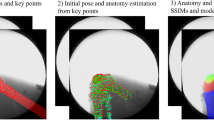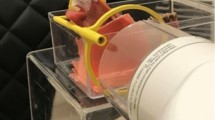Abstract
Patient-specific finite element (FE) modelling is a promising technology that is expected to support clinical assessment of the spine in the near future. To allow rapid, robust and economic patient-specific modelling of the whole spine or of large spine segments, it is practicable to consider vertebral cancellous bone in the spine as a continuum material, but the elastic modulus of that continuum material must reflect the quality of the individual vertebral bone. A numerical parametric model of lattice trabecular architecture has been developed for determining the apparent elastic modulus of cancellous bone Ecb in vertebrae. The model inputs were apparent morphological parameters (trabecular thickness TbTh and trabecular separation TbSp) and the bone mineral density (BMD), which can all be measuredin vivo, using the spatial resolution of current clinical quantitative computed tomography (QCT) commercial whole-body scanners. The model predicted that Ecb values between 30 and 110 MPa represent normal morphology and BMD of human spinal cancellous bone. The present Ecb to TbTh, TbSp and BMD relationships pave the way for automatic generation of patientspecific continuum FE spine models that consider the individual's osteoporotic or other degenerative condition of cancellous bone.
Similar content being viewed by others
References
Borah, B., Gross, G. J., Dufresne, T. E., Smith, T. S., Cockman, M. D., Chmielewski, P. A., Lundy, M. W., Harke, J. R., andSod, E. W. (2001). ‘Three-dimensional microimaging (MRμI and μCT), finite element modeling, and rapid prototyping provide unique insights into bone architecture in osteoporosis’,Med. Anat. Rec.,265, pp. 101–110
Boyd, S. K., Matyas, J. R., Wohl, G. R., Kantzas, A., andZernicke, R. F. (2000): ‘Early regional adaptation of periarticular bone mineral density after anterior cruciate ligament injury’,J. Appl. Physiol.,89, pp. 2359–2364
Crawford, R. P., Cann, C. E., andKeaveny, T. M. (2003a): ‘Finite element models predictin vitro vertebral body compressive strength better than quantitative compute tomography’,Bone 33, pp. 744–750
Crawford, R. P., Rosenberg, W. S., andKeaveny, T. M. (2003b): ‘Quantitative computed tomography-based finite element models of the human lumbar vertebral body: effect of element size on stiffness, damage, and fracture strength predictions’,J. Biomech. Eng.,125, pp. 434–438
Dagan, D., Be'ery, M., andGefen, A. (2004): ‘Single-trabecula building block for large-scale finite element models of cancellous bone’,Med. Biol. Eng. Comput.,42, pp. 549–556
Damrongrungruang, T., Kuroda, S., Kondo, H., Aoki, K., Ohya, K., andKasugai, S. (2004): ‘A simple murine model for immobilization osteopenia’,Clin. Orthop.,425, pp. 244–251
David, V., Laroche, N., Boudignon, B., Lafage-Proust, M. H., Alexandre, C., Ruegsegger, P., andVico, L. (2003): ‘Noninvasivein vivo monitoring of bone architecture alterations in hindlimb-unloaded female rats using novel three-dimensional microcomputed tomography’,J. Bone Miner. Res.,18, pp. 1622–1631
Ditsios, K., Boyer, M. I., Kusano, N., Gelberman, R. H., andSilva, M. J. (2003). ‘Bone loss following tendon laceration, repair and passive mobilization’,J. Orthop. Res.,21, pp. 990–996
Durand, E. P. andRuegsegger, P. (1991). ‘Cancellous bone structure: analysis of high-resolution CT images with the run-length method’,J. Comput. Assist. Tomogr.,15, pp. 133–139
Ebbesen, E. N., Thomsen, J. S., Beck-Nielsen, H., Nepper-Rasmussen, H. J., andMosekilde, L. I. (1999). ‘Age- and gender-related differences in vertebral bone mass density and strength’,J. Bone. Miner. Res.,14, pp. 1394–1403
Fagan, M. J., Julian, S., andMohsen, A. M. (2002): ‘Finite element analysis in spine research’,Proc. Inst. Mech. Eng. (H).,216, pp. 281–298
Ferguson, S. J., andSteffen, T. (2003): ‘Biomechanics of the aging spine’,Eur. Spine J.,12, pp. S97-S103
Fyhrie, D. P., andCarter, D. R. (1986): ‘A unifying principle relating stress to trabecular bone morphology’,J. Orthop. Res.,4, pp. 304–317
Gordon, C. L., Lang, T. F., Augat, P., andGenant, H. K. (1998): ‘Image-based assessment of spinal trabecular bone structure from high-resolution CT images’,Osteoporos Int.,8, pp. 317–325
Guo, X. E., andGoldstein, S. A. (1997): ‘Is trabecular bone tissue different from cortical bone tissue?’Forma,12, pp. 185–196
Harrigan, T. P., Jasty, M., Mann, R. W., andHarris, W. H. (1988): ‘Limitations of the continuum assumption in cancellous bone’,J. Biomech.,21, pp. 269–275
Hou, F. J., Lang, S. M., Hoshaw, S. J., Reimann, D. A., andFyhrie, D. P. (1998): ‘Human vertebral body apparent and hard tissue stiffness’,J. Biomech.,31, pp. 1009–1015
Kim, D. G., Christopherson, G. T., Dong, X. N., Fyhrie, D. P., andYeni, Y. N. (2004): ‘The effect of microcomputed tomography scanning and reconstruction voxel size on the accuracy of stereological measurements in human cancellous bone’,Bone,35, pp. 1375–1382
Laib, A., Hauselmann, H. J., andRuegsegger, P. (1998): ‘In vivo high resolution 3D-QCT of the human forearm’,Technol. Health Care,6, pp. 329–337
Lindh, M. (1989): ‘Biomechanics of the lumbar spine’, in Nordin, M., and Frankel, V. H. (Eds). ‘Basic biomechanics of the musculoskeletal system’ (Lea & Febiger, Philadelphia, London, 1989)
Lindsey, C. T., Narasimhan, A., Adolfo, J. M., Jin, H., Steinbach, L. S., Link, T., Ries, M., andMajumdar, S. (2004): ‘Magnetic resonance evaluation of the interrelationship between articular cartilage and trabecular bone of the osteoarthritic knee’,Osteoarthr. Cartilage,12, pp. 86–96
Majumdar, S., Genant, H. K., Grampp, S., Newitt, D. C., Truong, V. H., Lin, J. C., andMathur, A. (1997): ‘Correlation of trabecular bone structure with age, bone mineral density, and osteoporotic status:in vivo studies in the distal radius using high resolution magnetic resonance imaging’,J. Bone Miner. Res.,12, pp. 111–118
McCalder, R. W., McGeough, J. A., andCourt-brown, C. M., (1997): ‘Age-related changes in the compressive strength of cancellous bone. The relative importance of changes in density and trabecular architecture’,J. Bone. Joint. Surg. Am.,79-A, pp. 421–427
Mitton, D., Cendre, E., Roux, J. P., Arlot, M. E., Peix, G., Rumelhart, C., Babot, D., andMeunier, P. J. (1998): ‘Mechanical properties of ewe vertebral cancellous bone compared with parameters’,Bone,22, pp. 651–658
Mittra, E., Rubin, C., andQin, Y. X. (2005): ‘Interrelationship of trabecular mechanical and microstructural properties in sheep trabecular bone’,J. Biomech.,38, pp. 1229–1237
Morgan, E. F., Bayraktar, H. H., andKeaveny, T. M. (2003): ‘Trabecular bone modulus-density relationships depend on anatomic site’,J.Biomech.,36, pp. 897–904
Nordin, M., andFrankel, V. H. (1989): ‘Biomechanics of bone’, in Nordin, M., and Frankel, V. H. (Eds): ‘Basic biomechanics of the musculoskeletal system’ (Lea & Febiger, Philadelphia, London, 1989).
Pidaparti, R. M., andTurner, C. H. (1997): ‘Cancellous bone architecture: advantages of nonorthogonal trabecular alignment under multidirectional joint loading’,J. Biomech.,30, pp. 979–983
Pope, M. H., andDeVocht, J. W. (1999): ‘The clinical relevance of biomechanics’,Neurol. Clin.,17, pp. 17–41
Thomsen, J. S., Ebbesen, E. N., andMoskilde, L. (2002): ‘Zonedependent changes in human vertebral trabecular bone: Clinical implications’,Bone,30, pp. 664–669
van Rietbergen, B., Weinans, H., Huiskes, R., andOdgaard, A. (1995): ‘A new method to determine trabecular bone elastic properties and loading using micromechanical finite-element models’,J. Biomech.,28, pp. 69–81
van Rietbergen, B., Muller, R., R. Ulrich,Ruegsegger, P., andHuiskes, R. (1999): ‘Tissue stresses and strain in trabeculae of a canine proximal femur can be quantified from computer reconstructions’,J. Biomech.,32, pp. 443–451
van Rietbergen, B., Huiskes, R., Eckstein, F., andRuegsegger, P. (2003): ‘Trabecular bone tissue strains in the healthy and osteoporotic human femur’,J. Bone Miner. Res.,18, pp. 1781–1788
Author information
Authors and Affiliations
Corresponding author
Rights and permissions
About this article
Cite this article
Diamant, I., Shahar, R. & Gefen, A. How to select the elastic modulus for cancellous bone in patient-specific continuum models of the spine. Med. Biol. Eng. Comput. 43, 465–472 (2005). https://doi.org/10.1007/BF02344727
Received:
Accepted:
Issue Date:
DOI: https://doi.org/10.1007/BF02344727




